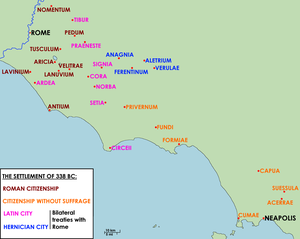Civitas sine suffragio
Civitas sine suffragio (Latin, "citizenship without the vote") was a level of citizenship in the Roman Republic which granted all the rights of Roman citizenship except the right to vote in popular assemblies. This status was first extended to some of the city-states which had been incorporated into the Republic following the break-up of the Latin League in 338 BCE.[1] It became the standard Romanization policy for incorporating conquered regions in building the Roman Empire.[2]

Sources
- Sherwin-White, A.N. (1973), The Roman Citizenship (2nd ed.), Oxford and New York: Oxford U.P.
- Velasco, J.C. (2010): "Civitas sine suffragio".
References
- ^ Arthur M. Eckstein (13 February 2007). Mediterranean Anarchy, Interstate War, and the Rise of Rome. University of California Press. pp. 253–. ISBN 978-0-520-93230-2.
- ^ Michel Humbert (1978). Municipium et civitas sine suffragio. L'organisation de la conquete jusqu'a la guerre sociale. - (Rome: 1978.) XIII, 457 S., 5 Kt., z. T. gef. 8°. Boccard.
- ^ Timothy J. Cornell, The Beginnings of Rome: Italy and Rome from the Bronze Age to the Punic Wars (c. 1000–264 BC), London, Routledge, 1995, pp. 349–351.
See also
